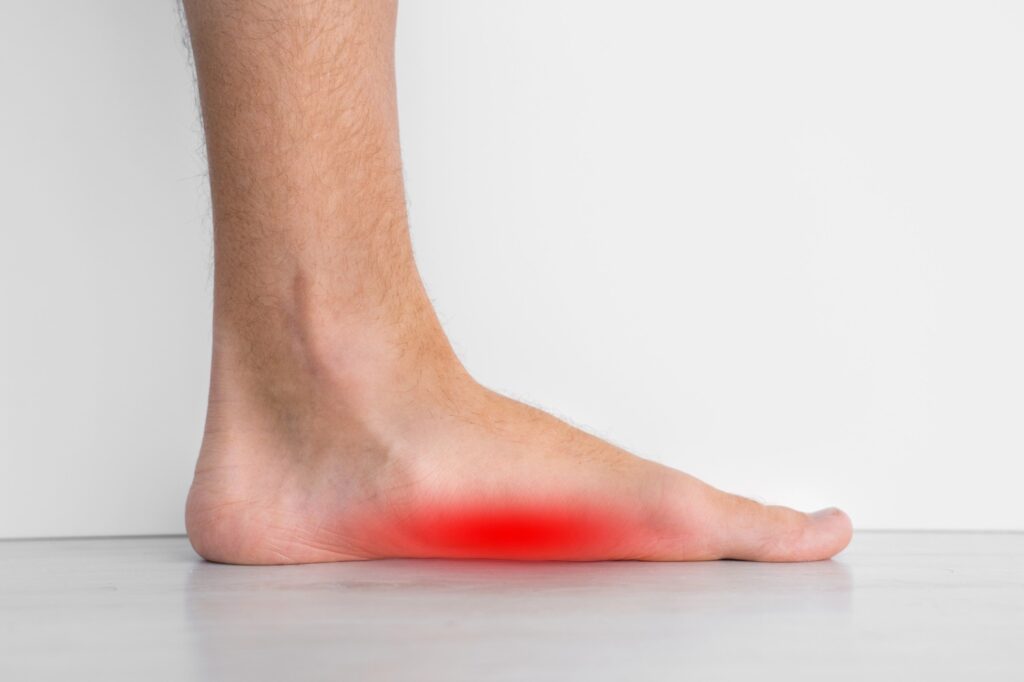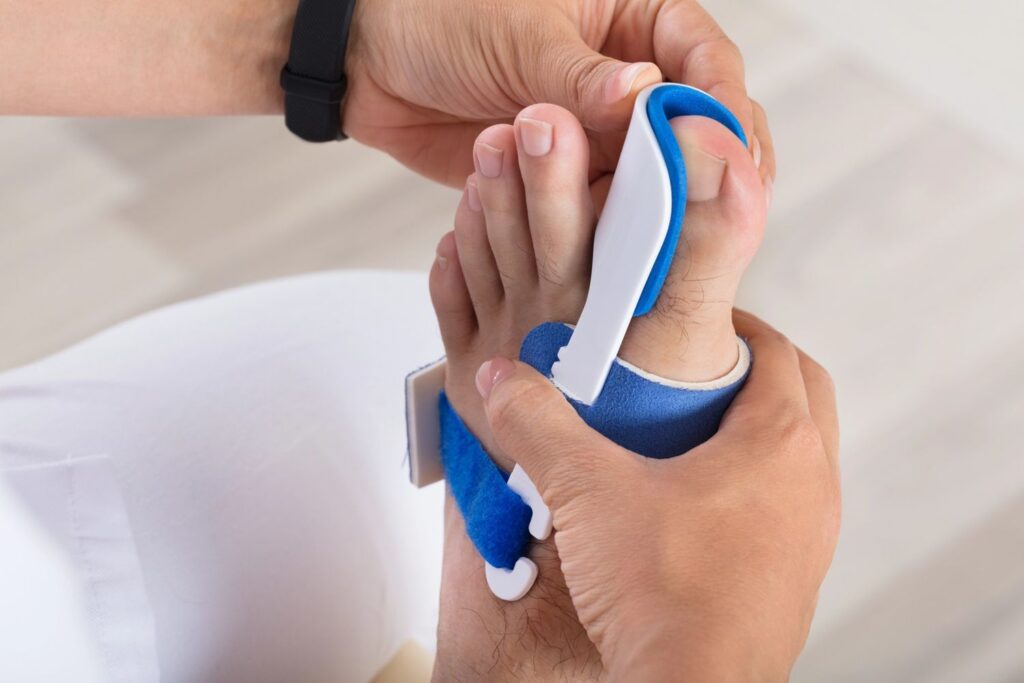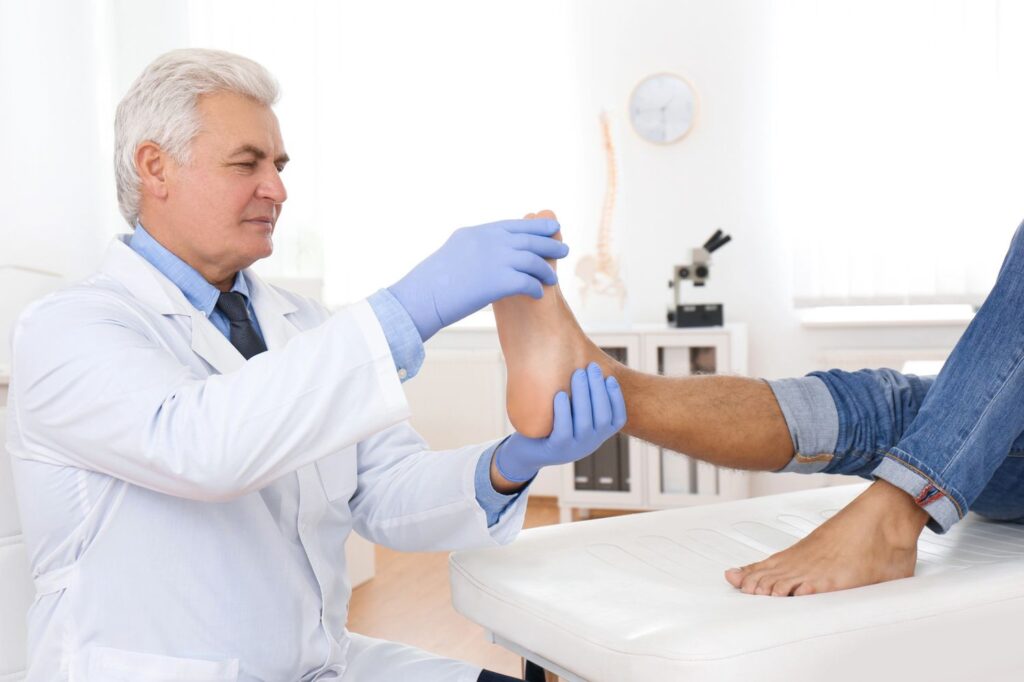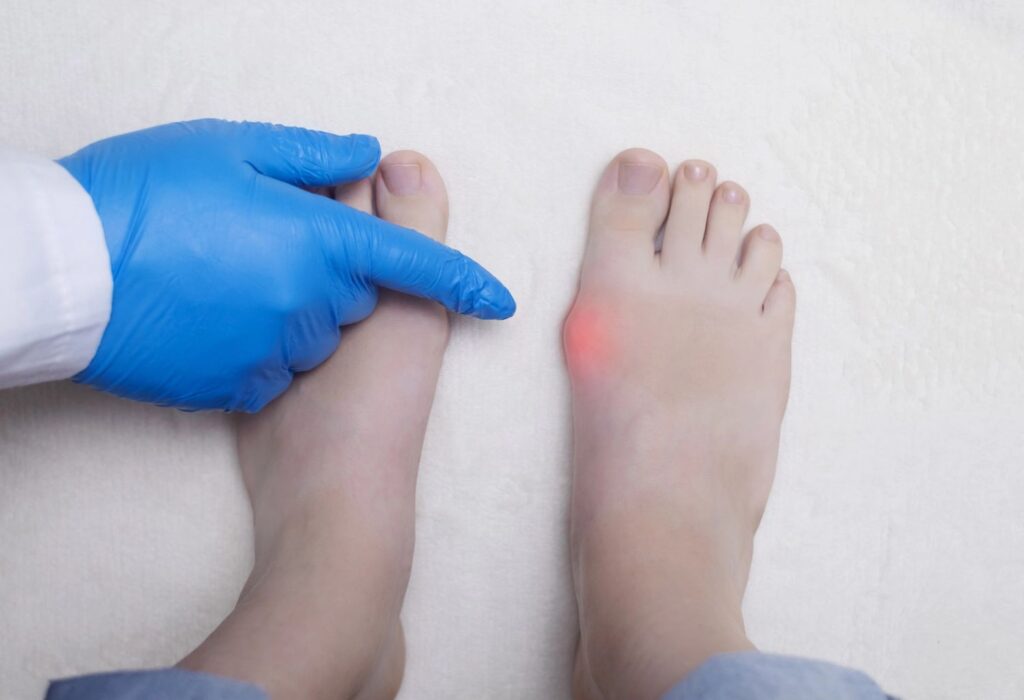Foot pain is one of the most common physical complaints among adults of all ages. Considering that our feet bear the body’s full weight and support us through thousands of steps each day, it’s no surprise they are prone to strain and discomfort. From dull aches that develop gradually to sudden sharp pains that appear after activity, foot pain can significantly affect your mobility and quality of life.
At Vital Podiatry Foot and Ankle Specialist, we often see patients who come in unsure about the exact cause of their foot pain. Sometimes it’s due to overuse or poor footwear, while other times it’s linked to structural abnormalities, injuries, or chronic conditions. Understanding what causes foot pain and recognizing its warning signs early can help prevent complications and keep you moving comfortably.

Plantar Fasciitis: The Leading Cause of Heel Pain
Plantar fasciitis is one of the most common causes of foot pain, especially heel pain. It occurs when the thick band of tissue (the plantar fascia) that runs along the bottom of your foot becomes inflamed. This tissue connects the heel bone to the toes and supports the natural arch of your foot.
What Causes Plantar Fasciitis?
The plantar fascia acts like a shock absorber, supporting the arch as you walk or run. Repeated stress, however, can lead to small tears in the tissue. Common triggers include:
- Repetitive impact from running, dancing, or standing on hard surfaces for long hours.
- Unsupportive footwear that lacks cushioning or proper arch support.
- Foot structure issues such as flat feet, high arches, or abnormal walking patterns.
- Age and body weight, which increase pressure on the heel and arch.
Symptoms and Treatment Options
Most people describe the pain as stabbing or sharp, especially during the first steps in the morning or after long periods of rest. As you move, the pain may lessen but often returns after extended standing or physical activity.
Treatment typically starts with rest, ice application, stretching exercises, and proper footwear. In more severe cases, podiatrists at Vital Podiatry Foot and Ankle Specialist may recommend orthotics, night splints, or physical therapy to promote healing and reduce inflammation.
Bunions: When the Big Toe Misaligns
A bunion is a bony bump that forms at the base of the big toe when the joint becomes misaligned. Over time, the big toe leans toward the second toe, pushing the joint outward and causing visible swelling and pain.
Causes and Risk Factors
- Inherited foot structure: Many people inherit a foot shape that makes them more likely to develop bunions.
- Tight footwear: High heels and narrow shoes force the toes into unnatural positions.
- Arthritis: Inflammatory conditions like osteoarthritis can cause joint instability and contribute to bunion formation.
Recognizing the Symptoms
Bunions can cause:
- Persistent pain or tenderness near the big toe joint
- Redness and swelling that worsen after standing or walking
- Restricted toe movement
- Difficulty finding shoes that fit comfortably
As bunions progress, they can lead to overlapping toes or secondary issues like corns and calluses. Non-surgical treatments include wearing wide-toe shoes, applying padding, and using orthotic inserts to relieve pressure. For severe cases, podiatrists may recommend surgical correction to restore alignment and eliminate pain.
Flat Feet and Fallen Arches: A Hidden Cause of Foot Fatigue
Flat feet, also known as fallen arches, occur when the natural arch of the foot collapses, causing the entire sole to touch the ground. Some people are born with this condition, while others develop it over time due to injury, age, or obesity.
How Flat Feet Affect Your Body
Without proper arch support, your feet may roll inward (overpronation), leading to uneven weight distribution and strain on the ankles, knees, hips, and even the lower back. Many people with flat feet experience fatigue or aching in the feet after standing for long periods.
Treatment and Management
Managing flat feet focuses on supporting the arch and improving alignment. Recommended strategies include:
- Custom orthotics that lift and support the arch.
- Strengthening exercises such as heel raises and toe curls.
- Supportive shoes with firm midsoles and shock absorption.
- Avoiding walking barefoot on hard surfaces.
At Vital Podiatry Foot and Ankle Specialist, patients with flat feet can undergo gait analysis to determine the right orthotic solution and exercise plan.
Achilles Tendonitis: Pain in the Back of the Heel
The Achilles tendon connects the calf muscles to the heel bone, allowing movement such as walking, jumping, and running. When this tendon becomes irritated or inflamed, it results in Achilles tendonitis, a painful overuse injury.
Common Triggers
- Sudden activity increase, especially in runners or athletes.
- Tight calf muscles that strain the tendon.
- Improper footwear that lacks heel support.
- Aging, which causes natural wear and tear of tendon fibers.
Recognizing the Symptoms
Pain typically starts as mild stiffness or soreness above the heel, worsening after physical activity. The area may also feel warm, swollen, or tender to the touch. Ignoring these signs can lead to tendon degeneration or even rupture.
Treatment Approaches
Rest, ice, and stretching are essential first steps. Supportive shoes and heel lifts can relieve tension on the tendon. Chronic cases may benefit from physical therapy, shockwave therapy, or regenerative treatments offered by podiatry specialists.
Arthritis: When Joints Become Painful and Stiff
Arthritis is a major cause of chronic foot pain, especially among older adults. It occurs when inflammation affects the joints, causing pain, swelling, and reduced motion.
Types That Affect the Feet
- Osteoarthritis: The result of gradual wear and tear on joint cartilage.
- Rheumatoid arthritis: An autoimmune disorder that attacks joint tissues.
- Post-traumatic arthritis: Develops after an injury to the foot or ankle.
Symptoms to Watch For
Arthritis pain often worsens with activity and may be accompanied by stiffness, swelling, and deformity around the affected joints. Over time, it can make walking or standing difficult.
Treatment and Lifestyle Support
Managing arthritis involves reducing inflammation and maintaining joint flexibility. Options include anti-inflammatory medication, physical therapy, orthotics, and lifestyle adjustments such as maintaining a healthy weight and wearing low-impact shoes.
Neuropathy: When Nerve Damage Causes Foot Pain
Peripheral neuropathy is nerve damage that leads to pain, tingling, or numbness in the feet. It’s often linked to diabetes, poor circulation, or prolonged nerve compression.
Recognizing Neuropathy Symptoms
People with neuropathy may feel burning or stabbing sensations in their feet. Some experience numbness that makes it hard to feel pain or temperature, increasing the risk of injury.
Why It Happens
- Diabetes-related nerve damage
- Poor blood circulation
- Vitamin deficiencies
- Injury or prolonged pressure on nerves
Prevention and Care
Regular foot checks, blood sugar management, and protective footwear can help reduce symptoms. At Vital Podiatry Foot and Ankle Specialist, we emphasize early detection and treatment to prevent complications like ulcers and infections.
Stress Fractures: Small Cracks That Cause Big Pain
Unlike full bone breaks, stress fractures are tiny cracks caused by repetitive impact or overuse. They are common among athletes, dancers, and individuals who suddenly increase their physical activity.
Symptoms and Risk Factors
You may notice localized pain that worsens with movement and eases with rest. Swelling, tenderness, and mild bruising are also common. Risk factors include poor bone density, improper footwear, and sudden increases in training intensity.
Healing and Prevention
Resting and avoiding high-impact activity allow the bone to heal. Podiatrists may recommend supportive footwear or immobilization devices. To prevent recurrence, gradual activity progression and maintaining healthy bone strength are key.

Corns, Calluses, and Ingrown Toenails: Small Problems, Big Discomfort
Even surface-level conditions like corns, calluses, and ingrown toenails can cause significant pain if not treated correctly.
Corns and Calluses
These thickened patches of skin form due to constant pressure or friction, usually from tight shoes or abnormal walking patterns. While they serve as a protective response, they can become painful over time. Moisturizing regularly and wearing well-fitted shoes can help manage them.
Ingrown Toenails
An ingrown toenail happens when the edge of the nail grows into the surrounding skin. It can cause redness, swelling, and sometimes infection. Avoid cutting nails too short or at curved angles. For persistent cases, podiatric treatment ensures safe nail removal and prevents recurrence.
9. When to See a Podiatrist
Foot pain that doesn’t improve within a few days should not be ignored. Persistent or severe symptoms often indicate underlying conditions that require professional evaluation.
Seek help if you experience:
- Swelling that doesn’t go down
- Numbness or tingling in the toes
- Pain that worsens with walking or exercise
- Visible deformities or open wounds
- Difficulty wearing shoes due to discomfort
Early diagnosis prevents minor issues from turning into chronic problems and restores proper function.
How Vital Podiatry Foot and Ankle Specialist Can Help
At Vital Podiatry Foot and Ankle Specialist, our team provides comprehensive care for all types of foot and ankle pain. From common conditions like plantar fasciitis and bunions to complex problems such as neuropathy and arthritis, we use a patient-centered approach that focuses on accurate diagnosis and lasting relief.
Our clinic offers advanced diagnostic imaging, customized orthotics, non-surgical therapies, and minimally invasive procedures designed to restore comfort and mobility. We believe that with the right treatment plan, every patient can achieve pain-free movement and return to their daily activities without discomfort.
Trusted Foot Doctor Walk-In Near Timber Meadow, Houston
When foot pain slows you down, you deserve expert care that’s fast, reliable, and close to home. At Vital Podiatry Foot and Ankle Specialist, we make it easy to get the relief you need, no appointment required. Our walk-in foot clinic near Timber Meadow, Houston is here to help you move comfortably again.
Whether it’s heel pain, bunions, ankle injuries, or diabetic foot concerns, our podiatrists deliver advanced care tailored to your needs right when you need it most.
Why Choose Vital Podiatry Foot and Ankle Specialist?
Walk-In Convenience, Expert Care
Life doesn’t wait when foot pain hits — and neither should you. We offer same-day walk-in care so you can see a foot specialist quickly and start your recovery immediately.
Experienced Podiatrists You Can Trust
Our team brings years of specialized experience treating everything from plantar fasciitis and bunions to Achilles tendonitis, ankle sprains, and nerve pain. We combine medical precision with genuine care for every patient who walks through our doors.
Advanced Technology for Accurate Diagnosis
Our Houston clinic near Timber Meadow uses state-of-the-art diagnostic tools to pinpoint the exact cause of your pain — so you get treatment that actually works, not just temporary relief.
Comprehensive Foot & Ankle Solutions
From custom orthotics and corrective treatments to diabetic wound care and sports injury recovery, we provide complete foot and ankle care under one roof.
Personalized, Patient-Focused Care
We take time to understand your pain, lifestyle, and goals. Every treatment plan is tailored to help you stay active, comfortable, and confident — whether you’re walking, working, or training.
Conditions We Treat
- Heel pain / Plantar fasciitis
- Bunions and hammertoes
- Ingrown toenails
- Flat feet and arch pain
- Diabetic foot care
- Achilles tendon injuries
- Sprains, fractures, and sports injuries
- Nerve and circulation issues
Whatever’s causing your pain, our podiatrists are ready to help you find relief fast.
Your Neighborhood Podiatrist Near Timber Meadow
Located near Timber Meadow, Houston, our clinic is convenient, professional, and welcoming. We’re proud to be the trusted choice for individuals and families who want top-quality podiatric care without waiting weeks for an appointment.
Walk In Today — Feel Better Tomorrow
Foot pain shouldn’t hold you back from the things you love. Walk in to Vital Podiatry Foot and Ankle Specialist today — your reliable foot doctor walk-in clinic near Timber Meadow, Houston — and take your first step toward lasting relief and healthier feet.
Location: Near Timber Meadow, Houston
Clinic: Vital Podiatry Foot and Ankle Specialist
Walk-Ins Welcome | No Appointment Needed
Vital Podiatry Foot and Ankle Specialist Serving the Timber Meadow Community and Beyond in Houston
Vital Podiatry Foot and Ankle Specialist is dedicated to serving the diverse needs of the local community of Houston, including individuals residing in neighborhoods like Timber Meadow. With its convenient location near landmarks such as TheChampions Community Church and major intersections like Timber Meadow Pines Dr and Gatton Park Dr(coordinates: 29.96889,-95.49677), we offer Foot doctor walk in Houston services.
Get Foot Doctor Walk in Services At Timber Meadow Now
CALL US NOW!
(281) 937-4546
Navigate from Timber Meadow to Vital Podiatry Foot and Ankle Specialist Now
Conclusion:
Foot pain can come from many different causes—structural, inflammatory, or nerve-related but every form of discomfort deserves attention. Ignoring pain can lead to worsening symptoms and limited mobility over time.
If you’re struggling with persistent foot pain, don’t wait for it to resolve on its own. Schedule a consultation with Vital Podiatry Foot and Ankle Specialist today. With expert care, modern technology, and personalized treatment plans, you can take confident steps toward long-term comfort and healthier feet.
FAQs
1. What are the most common causes of foot pain?
The most common causes of foot pain include plantar fasciitis, bunions, flat feet, Achilles tendonitis, and arthritis. These conditions can result from overuse, poor footwear, or structural problems in the feet. Other sources of discomfort include nerve issues (neuropathy) and stress fractures. At Vital Podiatry Foot and Ankle Specialist, we assess each case carefully to determine the exact cause and provide a customized treatment plan.
2. How do I know if my foot pain needs to be checked by a doctor?
If your foot pain lasts more than a few days, interferes with walking, or is accompanied by swelling, redness, or numbness, it’s best to see a podiatrist. Persistent pain may signal a more serious condition like tendonitis, arthritis, or a stress fracture. Early evaluation at Vital Podiatry Foot and Ankle Specialist helps prevent long-term damage and ensures faster recovery.
3. Can flat feet or fallen arches cause long-term foot pain?
Yes. Flat feet or fallen arches can lead to ongoing pain and fatigue in the feet, ankles, and even the knees or lower back. Without proper support, the lack of arch structure causes the feet to overpronate, placing strain on muscles and ligaments. Our specialists can provide custom orthotics and tailored exercises to restore balance and reduce pain.
4. What home remedies can help relieve mild foot pain?
For mild pain, simple steps can provide relief — such as resting your feet, applying ice for 15–20 minutes, wearing supportive shoes, and performing gentle stretching exercises. However, if pain persists or worsens, professional evaluation is necessary. Vital Podiatry Foot and Ankle Specialist offers expert diagnosis and targeted treatments to prevent the pain from becoming chronic.
5. Does wearing the wrong type of shoes cause foot pain?
Absolutely. Shoes that are too tight, too flat, or lack arch support are a common cause of foot pain. Over time, poor footwear can lead to bunions, plantar fasciitis, and calluses. We recommend shoes with proper cushioning, stability, and fit for your foot shape. Our podiatrists can also guide you in selecting footwear or orthotic inserts suited to your condition.










